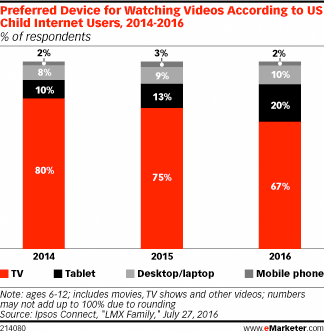How Digital Are Kids Today?
November 29, 2016
![]() Many kids become internet users before they learn how to walk. But even as the age at which kids get a smartphone creeps downward, most lack one of their own, as explored in a new eMarketer report, “US Kids and Digital: Gauging How Digital These Digital Natives Really Are”.
Many kids become internet users before they learn how to walk. But even as the age at which kids get a smartphone creeps downward, most lack one of their own, as explored in a new eMarketer report, “US Kids and Digital: Gauging How Digital These Digital Natives Really Are”.
 eMarketer estimates that 61.6% of kids ages 0 to 11 will use the internet at least once a month in 2016—lower than the rate for teens and most adults, but substantial for a cohort that includes babies.
eMarketer estimates that 61.6% of kids ages 0 to 11 will use the internet at least once a month in 2016—lower than the rate for teens and most adults, but substantial for a cohort that includes babies.
Naturally, usage is more common among older kids. In a May 2016 survey by KidSay among 8- to 11-year-olds, 51.0% of boys and 45.7% of girls said they use the internet “many times a day.” Another 15.2% of boys and 23.1% of girls reported using it once a day.
Even in the mobile era, significant numbers of kids go online via computer. In its latest “Total Audience Report,” covering Q2 2016, Nielsen identified 26% of 2- to 11-year-olds as at-least-monthly users of the internet via desktop/laptop computers.
 For some kids, internet usage is constrained because their families lack strong access. That was the focus of a February 2016 report by Sesame Workshop’s Joan Ganz Cooney Center, based on polling the previous spring among parents of kids ages 6 to 13 and with income below the US median. While 94% had “some kind of internet access,” 23% had mobile-only access. Among families in this income bracket who had home access, 20% said their internet “has been cut off in the last year due to lack of payment.” As for those with mobile-only internet access, 29% had hit the data limit on their plan during that period; 24% had had service cut off for lack of payment.
For some kids, internet usage is constrained because their families lack strong access. That was the focus of a February 2016 report by Sesame Workshop’s Joan Ganz Cooney Center, based on polling the previous spring among parents of kids ages 6 to 13 and with income below the US median. While 94% had “some kind of internet access,” 23% had mobile-only access. Among families in this income bracket who had home access, 20% said their internet “has been cut off in the last year due to lack of payment.” As for those with mobile-only internet access, 29% had hit the data limit on their plan during that period; 24% had had service cut off for lack of payment.
Income aside, digital access does not mean kids shun TV sets. Nielsen’s Q2 2016 report showed 2- to 11-year-olds averaged 19 hours 15 minutes per week watching live and DVR/time-shifted TV. This is consistent with what Ipsos Connect found in February 2016 when asking 6- to 12-year-olds to identify their preferred device for watching video. Sixty-seven percent chose the TV set. However, the proportion picking it was down by 13 percentage points from 2014.
Courtesy of eMarketer






























